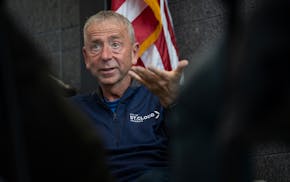President Obama had the right reaction after meeting Indian students during his trip to a North Dakota Indian reservation in June. Saying he and the first lady were "shaken" by the kids' pessimism about their futures, Obama returned home and took action.
He ordered his administration to "find new avenues of opportunity" for Indian youths. He instructed every member of his Cabinet to "sit down with Native young people and hear firsthand about their lives.'' The result of his agenda-setting came earlier this month when Obama announced a series of tribal youth initiatives at the White House Tribal Nations conference.
The speech was greeted with cheers. It should have been met with hard questions. The new initiatives, while welcome, are small steps that do nothing to address a critical educational hurdle on reservations: the ragged conditions of school buildings.
Online leadership networks, a "youth listening tour" and a "White House Tribal Youth Gathering" are poor substitutes for the safe, modern school buildings that the 183-school Bureau of Indian Education (BIE) system desperately needs. About a third of the schools in this federally funded K-12 system, which serves about 50,000 of the nation's poorest students, have decrepit facilities.
An effort to help Indian youths that does not include an overhaul of these 63 BIE schools cannot be taken seriously. At least $1.3 billion is required for rebuilding or renovation. What's needed is a swift commitment to secure funding, not lightweight initiatives.
Beginning Nov. 23, a Star Tribune Editorial Board series called "Separate and Unequal" documented the shameful state of BIE school buildings across the nation, as well as the growing gap between them and U.S. Department of Defense (DOD) schools, the other federally funded K-12 system.
Northern Minnesota's Bug-O-Nay-Ge-Shig High School is housed in a deteriorating pole barn. In Arizona, two BIE schools have been on a "priority waitlist" for a decade. In South Dakota, BIE schools are overcrowded and have sections of buildings that have been closed off or condemned.
At the same time, Department of Defense schools, which serve children of military families and civilian defense employees, are in the midst of a $5 billion, decadelong project to rebuild 134 schools and set a new national design standard for the future.
At the White House Tribal Nations conference, U.S. Interior Secretary Sally Jewell called the editorials "painful" but "helpful."
Jewell, whose Department of the Interior is the parent agency for BIE and the Bureau of Indian Affairs, deserves credit for recognizing the problems documented in the series. But now she needs to provide a concrete action plan to overhaul the schools — and a personal guarantee that she'll lobby Congress for the funding needed to launch a school construction surge like the DOD's. Secretary of Education Arne Duncan also needs to lend his considerable clout.
About a week ago, Congress signaled strongly that it's willing to hear the case for improved BIE school funding with the passage of the continuing resolution/omnibus spending bill. Tucked inside the bill, thanks to a timely push by Minnesota Rep. Betty McCollum, was $20 million for BIE school replacement in 2015, nearly $17 million more than Jewell's agency requested. The legislation also directed Interior to replace its decade-old "priority construction" list of schools.
But much more work needs to be done.
At the federal level:
• Minnesota's congressional delegation must take on the BIE school cause. McCollum, as well as Rep. Rick Nolan and Sen. Al Franken, all Democrats, have long been champions of BIE schools. Powerful Republican Reps. John Kline and Erik Paulsen also need to convince their caucus that this is a worthy investment. Kline, as chairman of the Committee on Education and the Workforce, especially could make a difference.
• Interior Department officials should tap the expertise of DOD school construction experts. The DOD staff is setting a new standard for school design and has experience managing a large rebuilding effort.
At the state level:
• Minnesota lawmakers must take the lead on building a new Bug-O-Nay-Ge-Shig high school. BIE school construction is a federal obligation, but federal action remains years, perhaps a decade, away. One BIE ranking of school construction needs indicated that 31 schools are ahead of the Bug school. State. Sen. Terri Bonoff's idea to form a new partnership with federal officials to finance a new Bug school also merits support.
• Gov. Mark Dayton should enlist Minnesota's nonprofit community to help build a new Bug school. The CEO of the influential Blandin Foundation has said that the organization is interested in getting involved and that covering the school's $27 million price tag is doable with the right partnerships.
The conditions at BIE schools are a national disgrace, one requiring immediate attention. Obama, Jewell and Congress cannot let the nation's two federally funded K-12 systems become one of haves and have-nots on their watch.
And Minnesota, which has a long history of helping communities with immediate needs that outstrip available resources, shouldn't wait for Washington to help the Bug school. Swift action is needed to ensure that another generation of American Indian kids will not have to attend high school in a broken-down building.

Kudos to St. Cloud's longtime mayor
Readers Write: Ethnic studies curriculum, public notice laws, student protests


